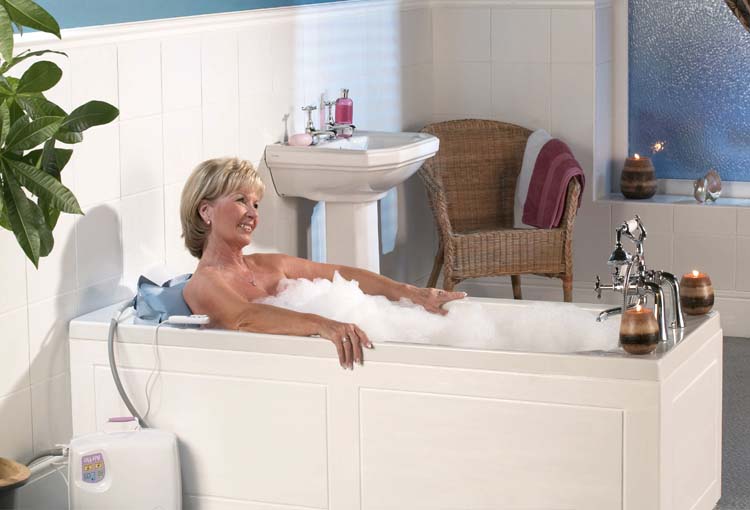‘Arthritis is a common condition that causes pain and inflammation in the joints’*, it affects around 10 million people in the UK and Osteoarthritis is set to reach 17 million by 2030 according to research conducted by the charity Arthritis Care1 and most of people diagnosed with the condition are over the age of 65, not only does it affect you physically it can have a huge affect on someone’s mental health as well.
* According to the NHS choices website (http://www.nhs.uk/Conditions/Arthritis/Pages/Introduction.aspx)
There are approximately 120 different types arthritis, the two most common are, Osteoarthritis and Rheumatoid arthritis. The type and severity of the symptoms varies and it is essential to have a clear diagnosis prior to any form of therapeutic intervention.
This article will,
- Review the clinical presentation of the two common types, Osteoarthritis and rheumatoid arthritis
- Discuss how a hot bath can improve pain and swelling, which can lead to improved occupational performance, if used as part of a holistic treatment programme.
Osteoarthritis (OA)
OA was historically thought to be a normal consequence of aging, leading to the term “degenerative joint disease.” However, it is now known that OA results from the interaction of multiple influences, including joint integrity, genetics, local inflammation, mechanical forces, and cellular and biochemical processes. This leads to
- Joint pain and tenderness
- Swelling of the joints causing reduced range of movement
- Boney deformities
- Joint instability and muscle wasting around affected joint
- Reduced ability to carry out day to day activities
Rheumatoid arthritis (RA)
Rheumatoid arthritis is a chronic inflammatory autoimmune disease characterised by progressive damage of synovial-lined joint. RA can affect any joint, but it is most commonly found in metacarpophalangeal, proximal interphalangeal and metatarsophalangeal joints. Symptoms following diagnosis can be but not limited to,
- Joint inflammation and pain
- Morning joint stiffness
- Fatigue
- Muscle wasting
- Rheumatoid Nodules
- Eyes: secondary Sjögren’s syndrome.http://www.nhs.uk/conditions/Sjogrens-syndrome/Pages/Introduction.aspx
- Reduced ability to carry out day to day activities
Early diagnosis and treatment is critical to ongoing management of the RA according to the National Institute for Health and Care Excellence (NICE)2 as this allows for the degeneration of the joints to be reduced and protected.
There is significant evidence that all forms of Arthritis impact on a person’s mental health and studies have shown that there is a 13-20% increased likelihood of depression due to the excruciating pain and loss of functional ability3
Therefore pain management and strategies to maintain Occupational performance are key in developing effective therapeutic interventions.
What are the benefits of a hot bath?
There is good reason why hot baths or hydrotherapy pools are routinely used by physiotherapists and pain management experts in the ongoing treatment of people with a diagnosis of OA and RA, as immersion in hot water stimulates the release of endorphins, these are naturally occurring neurotransmitters released from the pituitary gland in the brain that reduce pain and improve mood, thus having a positive affect on two of the most debilitating symptoms of the condition.
So why is this the case, immersion in warm water raises your body temperature, causing your blood vessels to dilate and increasing circulation, this results in less swelling and pain, and increases mobility. The soothing warmth and buoyancy of warm water makes it a safe and an ideal environment for relieving arthritis pain, stiffness and enables its user to carry out a range of movement in a supportive environment.
The additional benefit of a hot bath is that hot water prompts relaxation and the increase in body temperature helps you fall asleep faster and sleep more soundly, this then allows for a deeper sleep pattern and thus reduces the effect of fatigue.
The warm bath can therefore be used as part of a treatment progrmme to reduce the affects of pain prior to purposeful activity, e.g. social event, cooking, gardening or a round of golf or to aid sleep prior to a significant occasion which would have historically been to difficult to attend due to fatigue.
The healthcare professional involved with a client with RA or OA should look at creating clearly defined client centred goals which look at self-management, engagement in therapeutic activities and exercise programs that are essential to increase functional abilities, improve sleep, decrease depression and enhance overall health and well being.
- OA Nation 2004. Arthritis Carehttp://www.arthritiscare.org.uk/PublicationsandResources/Forhealthprofessionals/OANation
- Rheumatoid Arthritis NICE CKS, August 2013 (UK access only)
- Creed F. Psychological disorders in rheumatoid arthritis: a growing consensus.




